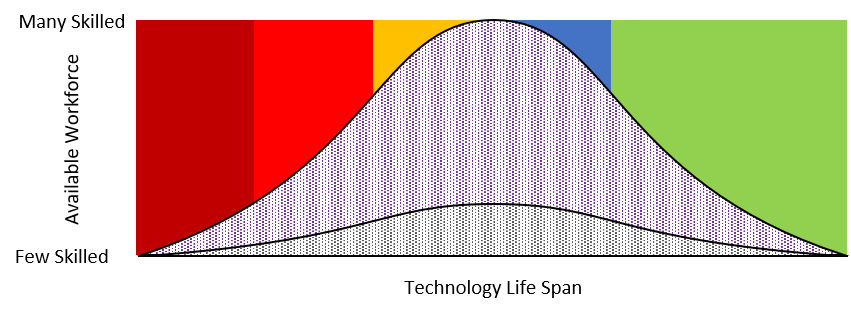Innovation is widely accepted to be a great thing—think of all the new products, technologies, methodologies, services, etc. unveiled at any given time. At this point, you’re probably thinking, “This all sounds great! Why would someone be writing about a downside of innovation?”
Innovation is great when it pushes the boundaries of what can be achieved and inspires people to build upon things others have built or dreamed of. But innovation is useless without adoption.
The Innovation Curve
Possibly the most famous adoption classification is from Everett Rogers’ book, Diffusion of Innovations. You might recognize the image below as an approximation of this classification, which was popularized in the technology space by Geoffrey A. Moore. If you’ve never heard of the Innovation Curve, it classifies the propensity of an individual or an organization to adopt a new technology or service. Certain characteristics and behaviors define each group, or classification of organizations.

Innovators—The first group of adopters are Innovators, who are usually technically focused. They’re interested in the nuts and bolts of how everything works, want to reverse engineer things for fun, and are likely to be alpha testers. Many Innovators might even write the code to fix the issues for you. Unfortunately, from a business perspective, Innovators will often test technologies or services but won’t be high-paying customers and may demand a lot of attention from your company.
Early Adopters—Early Adopters see value in new solutions and are willing to enter a riskier phase to gain large rewards. Early Adopters will help to better define the commercial scope of the technology or service being offered.
Early Majority—By the time the Early Majority arrive, the solution is in a fairly stable state and hitting mainstream status. If you’d like to read more about how to make the jump from the Innovator and Early Adopter stages to the Early Majority stage, I suggest reading “Crossing the Chasm” by Geoffrey A. Moore.
Late Majority—As you might expect, this group is behind the curve. If we were to relate the Late Majority to a business, it would be a relatively small business that doesn’t take note of the competition and what they’re doing. Their approach is insular, and they may be starting to wonder why other companies are having more success despite spending years promoting themselves on social media. Without a change in leadership style, the Late Majority will always be behind the curve and never reach their true potential.
Laggards—This is group is risk-averse. They’ll generally replace worn out technology with other solutions on their way out. For example, think of a relative swapping VHS tapes for DVDs in the age of streaming services.
Outlining the Problem
If you’re like most people, when you saw the Diffusion of Innovations bell curve, you were focusing on the colored sections. If you have sales or entrepreneurial tendencies, you might have even thought about go-to-market strategies or categorized where your solution or product currently fits on the curve and how to capitalize on the peak.
It’s extremely unlikely you were focusing on the white space around the curve; however, it’s possibly even more significant if your organization is using your latest innovation as a core part of your business platform.
For the rest of this example, I’ll use a fictional character, Celine the CIO, who has just started a proof of concept project using the latest in-memory, highly optimized database and analytical platform from AcmeIO. (It seems like you’re nobody in the startup world these days unless your company ends with “io.”)
Celine is a thought leader. She was at a virtual conference and saw a demonstration from a promising startup offering superb performance the likes of which the world has never seen. “Aha!” she thought, “This will be the ideal platform on which to build the next iteration of our accounting software. The current architecture isn’t coping with the demands of some of our largest customers, and if we don’t act soon, more of our customers will fall into this problematic segment.”
If we were to look at the graph above, Celine’s project would likely be taking place at the intersection of Innovators and Early Adopters.
Early benchmark tests from the new vendor, AcmeIO, suggest their throughput is through the roof and will meet their needs while achieving cost savings on their cloud provider of choice. Everyone’s delighted! Time to hire a project manager, architect, and development team to pull the magic together.
One slight issue, though—nobody has these skills yet. AcmeIO is so revolutionary that there’s little online documentation for fear of the competition gaining traction. There are no online videos; there’s not even a subreddit for it.
If we were to take the adoption curve above and invert it so the curve itself was white and add the same shades of classification to the outer areas, we notice a new phenomenon. I call this “The Skills Adoption Curve.”

People say a picture’s worth a thousand words, but pictures still need some explanation. Allow me to walk you through the image above.
The curve labeled “Career Interest Level Over Time” is identical to that of the adoption curve. The reason for this is the direct correlation between the adoption of the technology and the demand to meet this technology. Note the left axis, “Available Workforce,” will play an important factor in this curve. As more people discover the technology (i.e., it gains popularity within various IT communities), the higher and faster the rate rises for people to learn the technology as either a primary or secondary skill in their career.
As the pool of potential employees with this skill increases, more organizations can adopt and fully implement the technology in question. This can create a snowball effect as other entrepreneurs see business value in supporting this technology, creating revenue streams through areas such as monitoring and training. This further solidifies the position of the technology as a more mature platform and ushers in the age of the Early Majority.
It’s important to distinguish some definitions at this point. Adoption from a marketing standpoint would be the number of customers acquired, not necessarily the number of customers who have bought a technology and are actively using it. An exception to this could be some kind of software as a service (SaaS) solution; however, one could argue you can subscribe to a SaaS model and still not use it fully. It would be more apt to think of it as market penetration.
Internally, adoption would be thought of in terms of utilization and benefits received from the technology. For example, Celine’s company might have purchased licenses from AcmeIO and built their accounting software, but unless Celine’s customers are actively upgrading to the new version and seeing benefits, one could argue internal adoption is low.
Hopefully, you’ve realized we’ve identified a bottleneck to business growth. Celine’s bottleneck is a shortage of knowledge workers with a particular specialty—in this case, in AcmeIO and their programming language, AQL.
Identifying and Addressing Your Skills Gap

The shaded gray area represents the talent pool you might be able to attract based on factors such as seniority of position, salary, location, company brand image, etc. The purple section shows the total potential workforce, part of which may not be attractive to your company, as certain skill levels might not be sufficient.
Upskilling or reskilling your current staff is certainly an easy option if they have an aptitude for lifelong learning. This is generally considered a cheap way of attaining a more productive workforce and can be achieved by using a “train the trainer” model or outside training providers.
This can also be done using “High Tech, Low Touch” methods, which can include utilizing third-party software to perform several tasks rather than having to build and support in-house technology projects. You can read more about how to approach this decision in my blog post, “To Build or to Buy? That Is the Question.”
How Can You Tackle the Skills Gap in Your Company?
In October 2020, Microsoft announced a new program called “Get On 2021,” which aims to help 1.5 million people in the U.K. have careers in technology. This is great news. However, in the same period, it’s expected there will be a capacity of three million technology jobs.
Without a clear plan for how to tackle your own skills gaps, your business won’t be able to fully support your customers and achieve its full potential.
What hard and soft skills have you identified as areas of risk in your business?







